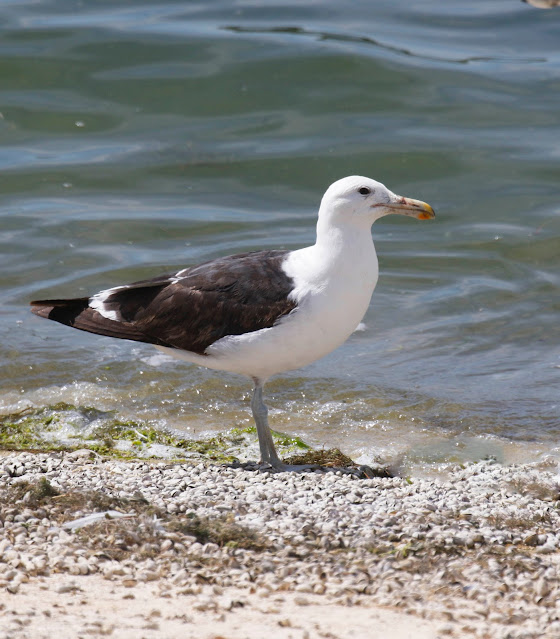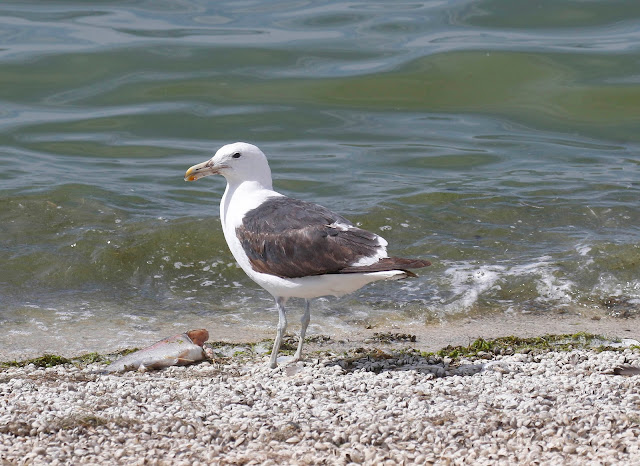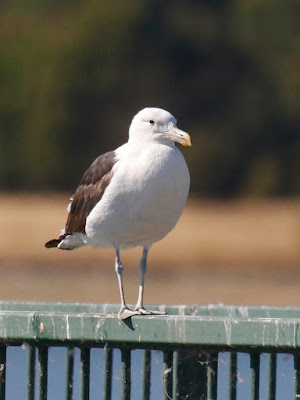So it was that I met Mark at his house at 7am on Tuesday and we ventured forth to endure the rush hour hell of traffic on two motorways that led us eventually to turn off into the industrial surrounds that lie near to the huge bridge spanning the River Thames and going by the name of the Dartford Crossing which takes you from Essex into Kent.
What we had not taken into consideration before setting off was the opening times at Rainham RSPB. We arrived at the not unreasonable hour of 8.30am only to find the access gates to the reserve firmly barred and they would only open at 9.30am. I am reluctant to criticise the RSPB as they do much good work but honestly 9.30am? Surely with the knowledge there was a 'good' bird on their reserve they could make some allowance for the dozen or so birders that were patiently waiting outside for them to open up. But no, the only concession made was to open up five minutes early.
In the meantime we stood on the path and looked at the mighty River Thames with its cargo vessels heading inland and then got chatting with a local birder, Bob, who told us something of the local history of Rainham and how it had once been a wartime rifle range, then a grazing marsh before a thousand acres was subsequently purchased by the RSPB, from the MOD in 2000, to finally become the splendid reserve it is today.
To add insult to our sense of injustice as we waited, we learned from Bob who had tried to see the Wryneck yesterday but failed, that it was just about as far away from the Visitor Centre as it could be. To get to see the Wryneck would entail a long but not unpleasant walk of around half a mile along a winding path and various boardwalks, passing through reedbeds and rough grassland to where the Wryneck was usually to be found, which was near the Rifle Butts, the only tangible evidence remaining of the reserve's former existence as a rifle range.
The Wryneck had been favouring a stretch of path near the rifle butts and showing down to a few feet in previous days but only in the morning, after which it would vanish for the rest of the day. So we were eagerly expecting a similar experience today, hence our early arrival but the RSPB had other ideas.
Setting off along the path, Bob regaled us about his current back problems as we were followed by around a dozen other birders. We were some two hundred metres from where the Wryneck had been consistently coming to feed on ants by the path when Mark said,
There it is!
What?
The Wryneck.
Where?
It's perched in that small hawthorn right in front of us. Near the top and out in the open. Its obvious.
This came as quite a surprise as we were certainly not expecting to see the Wryneck immediately but having to wait for it to appear and were also assuming we would see it in its usual location a few hundred metres further on and not in this bush right by the path. Still here it was and I wasted no time in raising the camera and recording it sat amongst the drought curled green leaves and red berries of the hawthorn.
Wrynecks are prone to sit for a few minutes in whatever bush they choose to perch in rather than flee immediately and this bird was true to type. It remained where it was for a couple of minutes, looking around but appearing reluctant to move, relying on its plumage of bars, stripes and spots of grey, brown and buff to provide an adequate camouflage.
Eventually as we stood, no more than metres away, it maybe realised the game was up and flew off across the reeds towards the river wall and perched there in the reeds, silhouetted on the skyline for several long minutes before flying back across the reeds to another cluster of small hawthorns further back along the pathway.
We duly followed but there was no sign of it for five minutes, then unexpectedly it popped up into one of the hawthorns, peering at us but frustratingly always contriving to perch in such a way that twigs leaves and berries were partially in the way.
Nevertheless, by means of contorting myself in the cramped space on the path I contrived to get most of it unobscured in my viewfinder and the end result was rather pleasing in that the bird and the habitat combined nicely to create a satisfying image that was not the usual full on side view of a bird that so much seems to be the desired result these days. Come to think of it I am becoming more and more drawn to this kind of bird imagery.
For some fifteen minutes it was visible, on and off, perched in one or other of the hawthorns but then flew fast and low out of the hawthorns and over the reeds to a bush near to its alleged favourite feeding spot on the path.
Hopes were raised that it would eventually drop down onto the path to feed Despite waiting for more than two hours and being told by local birders how well it had shown itself on the path the day before, it was not to be.
It was getting hot and approaching noon so we decided that the Wryneck was now a lost cause.It had never been seen in the afternoon and we would have to be content with the views we had of it earlier in the morning.
On the way back to the Visitor Centre and a refreshing cold drink we saw a couple of people stood on a small wooden bridge looking down at a wide waterfilled ditch below, running through the reeds.Curious we enquired what they were looking at
Marsh Frogs came the reply
We looked and indeed there were up to half a dozen Marsh Frogs below us, generally spaced well apart and resting half submerged in their amphibious, bug eyed way on the thick water weed in the ditch. These were by far the best views I have ever had of Marsh Frogs which on previous encounters have always seemed elusive and shy. Not these though.They sat for the most part motionless with just the occasional ponderous movement as they adjusted their position and were apparently untroubled by us gawking at them from above.
Maybe they have become used to the many visitors to the reserve and know they are safe.
Marsh Frogs were first found on the reserve in 2003 and have now multiplied so that they are found in every water filled ditch on the reserve and their distinctive croaking is a feature of the reserve both in Spring and as we could hear with our own ears, also in late summer.
Howard Vaughan, formerly of the RSPB at Rainham has written that they come in a variety of colours and patterns, some warty, some blotchy, some with long tramlines up their backs. They can be all shades of olive and brown with the odd Kermit green one standing out like a sore thumb against the dark green of the weed filled water. Further more he adds that there are three very similar species of these large frogs that make up the Green Frog complex. Their origins in England are unknown but in 1930 a lady entrepreneur decided to capitalise on the trend for French cuisine and decided to farm frogs on Romney Marsh in nearby Kent. She collected her stock from Hungary but did not bring back pure Edible Frogs but the very similar but also edible Marsh Frog which duly escaped from her farm and subsequently spread and multiplied across the south east of England. This species is certainly the most prevalent but there are also colonies of pure Edible Frogs to be found as well as a third species, the very rare Pool Frog. It is thought that the frogs at Rainham could comprise of both Marsh Frog and Edible Frog and even hybrids.
The frogs I saw did indeed vary in size, shape and colour. Not one was the same. Some were small and bright green whilst others were larger and browner or olive but all were intricately marked with darker bars and irregular shapes and patterns of varying hues. Presumably, as with our Common Frog, the larger ones were female whilst the brighter coloured, smaller frogs were males but maybe not
I found a sense of calm watching the frogs, allowing myself to relax into their silent watery world as they sat like miniature buddhas on the weed, the reeds gently stirring and rustling in the wind whilst the sun created dappled patterns of shadow and light. Look up and on the periphery of the reserve is another world of urban humanity, the motorway and bridge with its ceaseless traffic going back and fore, the main line railway populated by the silver snakes of high speed trains, the river and its ships, cranes and industrial warehouses, all accompanied by a background hum of un-natural mechanical noise.
A Marsh Frog croaked. A natural sound in this urban landscape. I looked down and all was forgotten.












.jpg)



























.jpg)
.jpg)


.jpg)





















